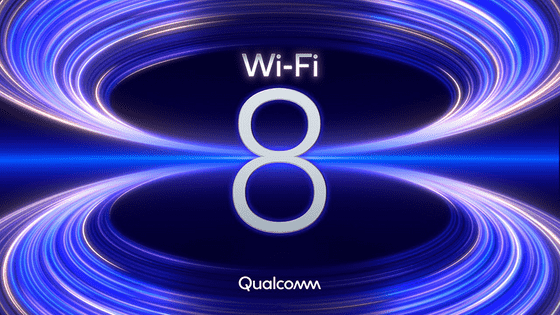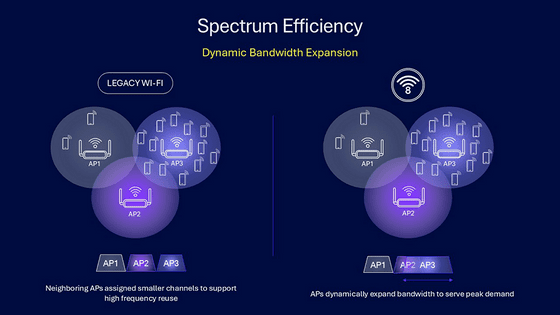Qualcomm explains what Wi-Fi 8 is and what makes it convenient, improving speed and stability during congestion

'Wi-Fi 8,' which is being developed as the next-generation wireless communication standard, is designed to achieve 'Ultra High Reliability' with an emphasis on stability. Qualcomm explained what Wi-Fi 8 is like.
Wi-Fi 8: Technologies powering ultra-high reliability | Qualcomm
◆1: Technology that supports ultra-high reliability
Wi-Fi is structured in multiple layers, with the two most important being the physical layer (PHY) and the medium access control layer (MAC). The PHY layer is responsible for the actual transmission of data over the air and defines how bits are converted into radio frequency signals (modulation, coding, signal strength, etc.). The MAC layer manages how devices access the shared wireless medium, coordinating when and how data packets are sent to avoid collisions and ensure spectral efficiency.
Wi-Fi 8 is based on the IEEE 802.11bn standard, which includes improvements and enhancements to the PHY and MAC layers to improve reliability, throughput, and responsiveness, especially in harsh environments.
Improved Low-Density Parity Check (LDPC) Coding : Packet loss and retransmissions significantly degrade performance in high-throughput and poor-signal environments. Wi-Fi 8 extends the block length of LDPC coding, significantly improving error correction and decoding performance. This reduces packet loss and improves connection reliability, even in noisy or congested environments.
Inter-spatial stream modulation level adjustment (UEQM) : Traditional MIMO systems force identical modulation levels across all spatial streams due to their 'weakest stream limited' nature. Wi-Fi 8 removes this constraint, allowing each stream to adapt its modulation based on its individual signal quality. This enables higher throughput and greater resilience, even in environments with uneven signal propagation.
Additional Modulation and Coding Scheme (MCS) : MCS is a combination of modulation scheme and coding rate that defines how data is encoded for wireless transmission and determines the achievable data rate. In traditional Wi-Fi, the coarse granularity of available MCS levels limited optimal rate adaptation in fluctuating signal environments, resulting in suboptimal performance. Wi-Fi 8 introduces intermediate MCS levels, enabling finer granularity of rate adaptation. This enables smoother transitions and more stable performance in scenarios where signal quality changes rapidly, such as mobile environments and dense public spaces.
Enhanced Long Range (ELR) : Network edge devices, such as outdoor cameras, garage sensors, and mobile robots, can experience weak upstream signals due to power limitations. This leads to an upstream/downstream power imbalance, where the access point (AP) transmits at a higher power than its clients. ELR resolves this imbalance and improves the link budget, effectively extending the network reach and helping low-power, far-away clients maintain reliable connections.
Distributed Resource Unit (DRU) : In the 6 GHz band, total transmit power is constrained by power spectral density (PSD) regulations that limit transmit power per MHz. For devices using small resource units, such as 26-tone or 52-tone, for OFDMA transmission, this limitation reduces communication range and reliability. Wi-Fi 8 solves this problem with the DRU, which allows tones to be distributed over a wider frequency band, effectively increasing total transmit power within PSD limits. In areas with more stringent PSD restrictions, this technology provides power gains and significantly improves signal robustness. The result: expanded coverage, improved link reliability, and improved client performance.
Single Mobility Domain ( SMD) Roaming : Single Mobility Domain (SMD) is a key feature of Wi-Fi 8, enabling seamless roaming across multiple access points without handoff interruptions that cause packet loss, latency spikes, and disconnections. Traditional Wi-Fi roaming involves disconnecting from one AP and reconnecting to another, resulting in latency and data discontinuities. This 'disconnect-first' roaming results in latency spikes, packet loss, and a poor user experience, disrupting voice and video playback while moving. In a Single Mobility Domain, multiple APs are logically grouped into a unified domain. Client devices maintain their association and security context across multiple APs, remaining continuously connected even as they move between APs. SMD roaming is handled by a 'connect-before-disconnect' mechanism, whereby devices establish a new connection before disconnecting the old one. These innovations enable Wi-Fi 8 to deliver seamless connectivity and consistent performance for users and devices as they move between coverage zones.

Spectral efficiency : Wi-Fi 8 introduces several mechanisms to improve spectral efficiency, especially in high-density environments and situations where devices with different capabilities need to coexist efficiently.
Dynamic Sub-Band Operation (DSO) : Typically, only premium clients can fully utilize the 320MHz or 160MHz bandwidth offered by current APs, leaving portions of the spectrum unused and inefficiently allocated. DSO allows multiple narrowband devices to operate simultaneously in different portions of a wideband channel, maximizing spectrum utilization and improving throughput in mixed-device environments.
Non-Primary Channel Access (NPCA) : When the primary channel is congested with overlapping BSS (BSS) traffic or other conditions, NPCA allows Wi-Fi devices to opportunistically access a secondary channel. The primary benefit is that stations can switch to a designated NPCA channel and continue transmitting data instead of waiting for the primary channel to become free. This improves overall network efficiency and reduces transmission latency in high-density environments. Specifically, NPCA mitigates the impact of channel congestion by neighboring networks by allowing devices to dynamically switch and compete for access on less congested channel frequencies. This results in higher throughput, lower latency, and improved spectrum utilization, especially in scenarios where multiple networks overlap and compete for airtime on the same primary channel.
Dynamic Bandwidth Expansion (DBE) : Enterprise deployments tend to avoid wideband channels due to frequency reuse constraints. DBE allows APs to temporarily expand the operating channel bandwidth during periods of high traffic, improving throughput without disrupting legacy clients when other channels are underutilized.
Multi-AP Cooperation : In dense environments with overlapping networks, unmanaged interference and contention can severely degrade performance. Wi-Fi 8 introduces a cooperation mechanism that allows APs to operate as a unified system, reducing collisions and improving spectral efficiency.
Cooperative TDMA (Co-TDMA) : APs share transmission opportunities in a time-sliced manner, reducing contention and latency. By distributing airtime among cooperating APs, Co-TDMA provides predictable access and improved performance for latency-sensitive applications.
Cooperative Restricted Target Wake Time (Co-rTWT) : APs coordinate access window timing to facilitate prioritized access for latency-sensitive traffic, achieving more deterministic performance even in congested environments.
Cooperative Beamforming (Co-BF) : APs use advanced antenna steering to focus signals on clients and reduce interference to neighboring APs, improving signal quality, reducing contention, and improving spectrum reuse efficiency in dense deployment environments.
Cooperative Spatial Reuse (Co-SR) : Allows APs to dynamically adjust transmit power based on link conditions between specific clients, enabling simultaneous co-channel transmissions in high-density multi-AP deployment scenarios. This feature improves overall throughput and efficiency in high-density environments.

◆2: Applying Wi-Fi 8 features to real-world environments
Wi-Fi 8 is designed for real-world impact, not just theoretical performance improvements: its innovations are tailored to the realities of modern connectivity, where reliability, responsiveness, and efficiency are crucial.
Enterprise and industrial environments have long relied on wired Ethernet to meet stringent operational requirements that require ultra-reliable, low-latency connections for robotic assembly, real-time monitoring, high-quality conferencing, AI-driven automation, etc. Wi-Fi 8 presents the opportunity to deliver the same reliability wirelessly.
For example, a single mobility domain allows autonomous mobile robots to navigate a vast factory floor without experiencing throughput degradation or latency spikes, and technicians using XR headsets can move between APs while maintaining a seamless video feed without buffering or interruptions.
In high-density deployments typical of enterprise campuses and factory environments, multi-AP cooperation techniques such as Cooperative TDMA (Co-TDMA) and Constrained Target Wake Time (Co-rTWT) enable APs to jointly manage transmissions. In factory environments where autonomous robots rely on real-time control updates, these techniques reduce contention and mitigate interference by sharing transmission opportunities and enforcing exclusive access windows for delay-sensitive traffic, thereby enabling deterministic operation of time-sensitive industrial systems.
At the network edge, Enhanced Long Range (ELR) and improved LDPC coding extend coverage and improve reliability for devices operating in harsh RF environments, such as surveillance cameras and IoT sensors.
In residential environments, Enhanced Long Range (ELR) and Distributed Resource Units (DRUs) improve uplink reliability for remote devices and IoT endpoints such as cameras and sensors, maintaining a strong connection even in areas far from the router.
Additional modulation and coding schemes (MCS) enable more granular rate adaptation, stabilizing performance in dynamic environments and supporting bandwidth-intensive applications like streaming and gaming.
In homes with multi-AP mesh networks, multi-AP cooperation allows nodes to efficiently manage fronthaul and backhaul traffic, while the Single Mobility Domain (SMD) feature set has the potential to significantly improve the overall experience for users as they move around the home while staying connected.
Additionally, power efficiency features on both clients and APs enable always-on residential gateways to consume less power, supporting sustainability goals without sacrificing responsiveness.
In public venues such as airports, stadiums, and transportation hubs, Wi-Fi 8 addresses the dual challenges of high user density and constant mobility.
Key features such as Multi-AP Coordination, Dynamic Sub-band Operation (DSO), and Non-Primary Channel Access (NPCA) work together to significantly improve capacity and manage interference in congested environments. Coordinating transmissions across multiple access points reduces collisions and maximizes throughput with low latency, even when thousands of devices are competing for bandwidth.
Meanwhile, Dynamic Bandwidth Expansion (DBE) allows APs to temporarily expand their operating channels to accommodate traffic spikes. For example, during halftime shows or rush hour at the airport, when many people are simultaneously streaming high-definition video or uploading content, Wi-Fi 8 APs can temporarily open up wider channels to accommodate the surge in demand, ensuring no one experiences slower speeds during peak usage.
The Single Mobility Domain feature further enhances the user experience by enabling seamless roaming between APs. As users move around the venue, devices are handed off between APs without dropping the connection, eliminating audio and video interruptions during calls and streaming.
Qualcomm explained that Wi-Fi 8 is a combination of innovative technologies that will enable systems to operate with the accuracy, responsiveness, and reliability previously limited to wired infrastructure, while also delivering significantly faster wireless connections in scenarios where traditional Wi-Fi struggles.
Related Posts:
in Note, Posted by log1p_kr







